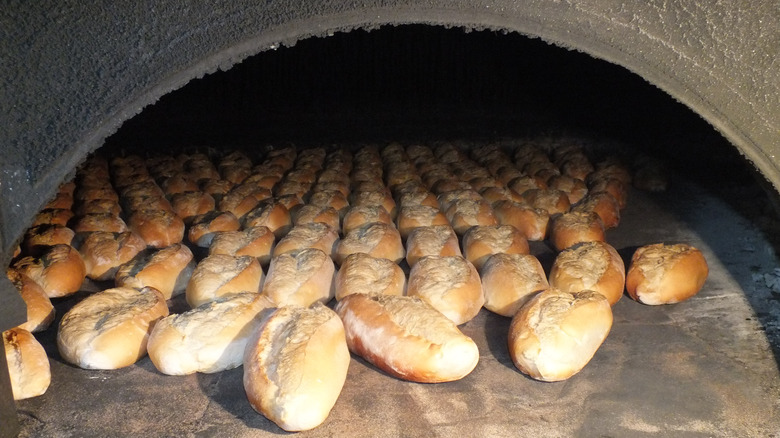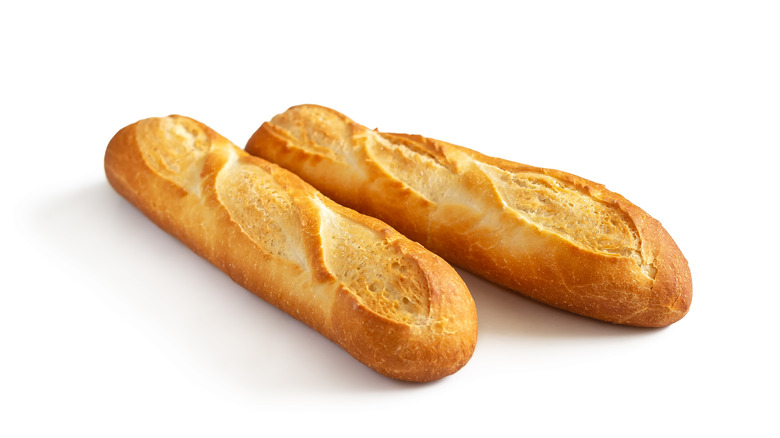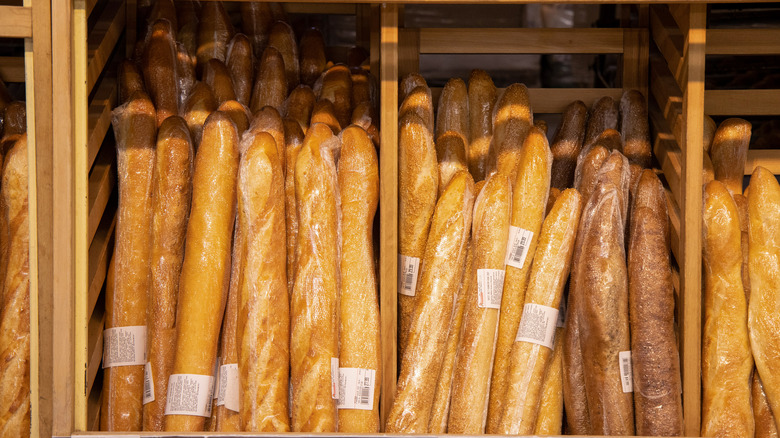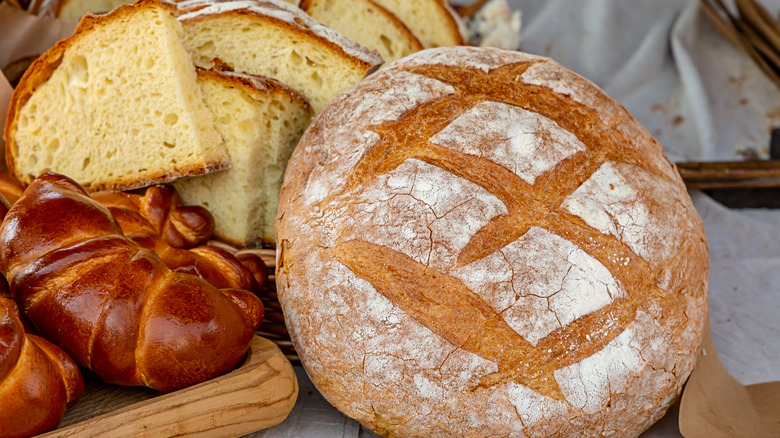The Morbid French Folklore Behind An Upside-Down Baguette
Just like the U.S., France has its fair share of superstitions. Like Americans, the French believe that Friday the 13th and broken mirrors are unlucky, while four-leaf clovers are lucky. While France doesn't take the black cat stereotype too seriously, those felines have also traditionally been associated with misfortune in France, according to French Together. The French also cross their fingers to hope for the best and knock on wood to keep things going well.
However, a few French traditions regarding luck differ from those of many Americans. Touching the red pom-pom on a sailor's beret is supposed to bring good luck. Another positive action? Stepping in dog poop — very common on French sidewalks — with your left foot specifically. Poop is also the way to tell an actor to "break a leg" — you tell them the French word for poop before a show. Another very specifically French superstition is that placing a loaf of the bread known as a baguette upside-down brings bad luck. So why is that?
Why it's bad luck
According to some, this specific belief dates back to the Middle Ages, and it relates to executions. Executioners in the Middle Ages were both hated and feared, according to Flavors of Paris, so much so that the king had to pass a law to force bakers to sell products to them. After that, any loaf of bread made for an executioner would be filled with the baker's hostility, according to tradition.
From there, the story splits into two different versions. The first: Executioners didn't have to pay for their bread. They could walk into a bakery, not talk to anyone, and take whatever they could hold in one hand (via Flavors of Paris and Curious Rambler). Therefore, the baker would reserve the worst loaves for the executioner and turn them upside-down so no one else would get them by mistake.
The other version is that executioners were too busy on certain days, usually market days when lots of people would be out and about, and thus lots of executions were scheduled for public viewing. Because of this, executioners would be too busy to pick up their bread until later in the day, so the bakers would reserve their best baguettes for the executioners and put them upside-down to distinguish them from less perfect baguettes (via Curious Rambler). Either way, upside-down baguettes were associated with death.
What happens if you turn one upside-down?
Putting a baguette upside down, whether by accident or not, can have several bad outcomes, according to tradition. One is that it can cast a hunger curse on you, according to Flavors of Paris. The result? You may not have enough to eat, or you may not feel hungry even when you do eat, and the same will apply to anyone who eats part of that baguette.
Because this superstition is associated with executioners and death, putting your baguette upside-down can mean you're symbolically inviting death into your home. Less specifically, you could be inviting in any kind of evil. Some even go so far as to say the devil himself will come to your home if your baguette is upside-down, according to Curious Rambler. Don't worry, though: if you turn one upside-down by accident, you can counteract the bad luck by cutting a cross into the flat side of the bread before slicing it (via Flavors of Paris).
The invention of the baguette
Though the baguette is considered a quintessential part of French cuisine, it's not actually as old as you might think. Baguettes were probably invented between 1830 and 1900, and there are a few different theories as to how, according to Connexion France. One is that oval-shaped bread originated in Vienna and eventually evolved into the baguette. If so, this shape was probably brought to Paris when Austrian baker August Zang opened a shop there in 1839.
A second theory is that when a law decreed that bakers couldn't work before 4 a.m., they started looking for a type of bread that was quicker to bake and then adopted Zang's oval loaves. There's also a theory that the baguette was invented thanks to Emperor Napoleon III (the nephew of the more famous Napoleon). The story goes that he asked bakers to create a loaf of bread that his soldiers could carry either in their pants or their boots. Thus, the baguette — a loaf typically shaped as long and relatively slender — was born (via Connexion France).
The particulars of the tradition
Notice a problem here? If baguettes were invented in the 19th century, how can a superstition regarding them date back to the Middle Ages? The tradition may not be as old as people think, but alternately, it may have originally related to any type of loaf of bread, according to Connexion France. The Middle Ages had many different types of bread, and what you ate varied by social class, with the elites eating the whitest bread, and the poor eating the darkest and coarsest bread (via Cookist). Whether executioners got the best or worst bread, their loaves would stand out not just by positioning, but by color and texture. The same tradition actually continues today — placing any loaf of bread upside-down is said by some to bring bad luck. It doesn't only apply to baguettes (via Connexion France).
How can you tell which side is up? A baguette generally has one flat side and one rounded side, and the flat side is the bottom, according to French Together. In other words, always put your baguette round-side-up. The same would apply to any loaf of bread with one flat side.
Why were executioners so busy?
So why were these medieval executioners too busy to come get their bread? Execution in the Middle Ages took many different forms: hanging, decapitation, drowning, burning, and breaking on a wheel. The method depended on the crime, and many crimes were punishable by death, including theft, murder, rape, arson, heresy, sodomy, witchcraft, incest, and adultery (via Medievalists). However, the death penalty wasn't applied as widely as people today might think. According to CRNS News, between the 13th and 16th centuries, judges looked for as much evidence of guilt as possible, and the evidence had to be rock-solid. Even then, banishment was as common a punishment as death.
Still, medieval executioners may have stayed busy because even with judges trying to do their best, there was less concern then about sentencing an innocent person to death than there is today. Because justice was linked to Christianity in much of medieval Europe, the death penalty allowed a person to repent of their crime and become closer to Christ through the suffering of their execution. All this would prepare them for the afterlife, thus, it would do the same for an innocent person (via Medievalists). With both the innocent and the guilty put to death, that meant a lot of bread for a lot of executioners.





